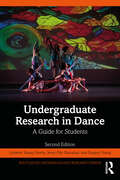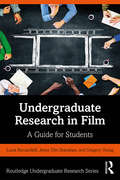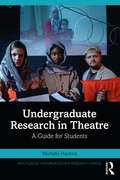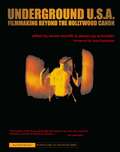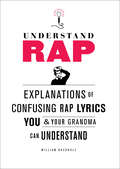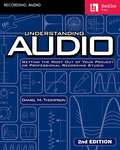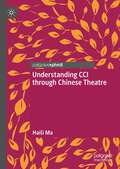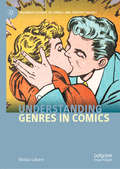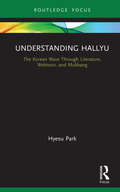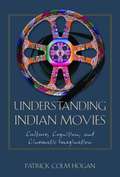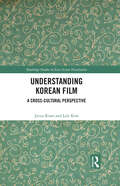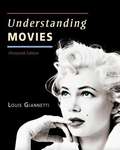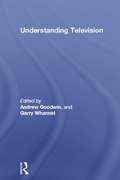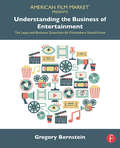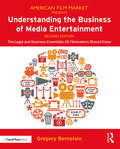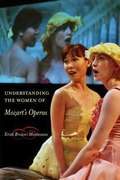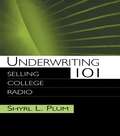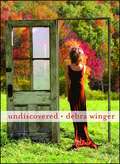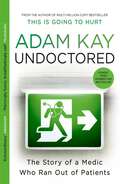- Table View
- List View
Undergraduate Research in Dance: A Guide for Students (Routledge Undergraduate Research Series)
by Jenny Olin Shanahan Gregory Young Lynnette Young OverbyUndergraduate Research in Dance: A Guide for Students supplies tools for scaffolding research skills alongside examples of undergraduate research in dance scholarship. Dance can be studied as an expressive embodied art form with physical, cognitive, and affective domains, and as an integral part of society, history, and vast areas of interdisciplinary content. To this end, the guidance provided by this book will equip future dance professionals with the means to move the field of dance forward. Chapters 1–9 guide students through the fundamentals of research methods, providing a foundation to help students get started in understanding research protocols and processes. Students will learn skills such as how to choose a research topic, refine research questions, conduct literature reviews, cite sources, synthesize and analyze data, develop conclusions and results, and present their findings. Chapters 10–19 detail forms of undergraduate research in a rich diversity of fields within dance that are taught in many collegiate dance programs including dance therapy, history, science, psychology, education, and technology, in addition to public scholarship, choreography, and interdisciplinary topics. The book also includes a final chapter which provides annotated online resources, and many of its chapters are supported by examples of abstracts of capstone projects, senior theses, and conference presentations by undergraduate researchers across the United States. Suitable for both professors and students, Undergraduate Research in Dance is an ideal reference book for any course that has a significant opportunity for the creation of new knowledge, or as an essential interdisciplinary connection between dance and other disciplines.
Undergraduate Research in Dance: A Guide for Students (Routledge Undergraduate Research Series)
by Jenny Olin Shanahan Gregory Young Lynnette Young OverbyUndergraduate Research in Dance: A Guide for Students supplies tools for scaffolding research skills, alongside examples of undergraduate research in dance scholarship. This second edition has been updated throughout for current students, with new chapters on mentoring and dance studies.Dance can be studied as an expressive embodied art form with physical, cognitive, and affective domains, and as an integral part of society, history, and vast areas of interdisciplinary content. To this end, the guidance provided by this book will equip future dance professionals with the means to move the field of dance forward. Chapters 1–9 guide students through the fundamentals of research methods, providing a foundation to help students get started in understanding research protocols and processes. A new chapter 10 provides guidelines for mentoring undergraduate students in dance. Chapters 11–21 detail forms of undergraduate research in a rich diversity of fields within dance that are taught in many collegiate dance programs including dance therapy, history, science, psychology, education, and technology, in addition to public scholarship, choreography, and interdisciplinary topics. A new chapter on dance studies has been added to this second edition. The book also includes annotated online resources, and many of its chapters are supported by examples of abstracts of capstone projects, senior theses, and conference presentations by undergraduate researchers across the United States and globally.Suitable for both professors and students, this book is an ideal reference book for dance studies as well as humanities and arts courses intersecting with dance.
Undergraduate Research in Film: A Guide for Students (Routledge Undergraduate Research Series)
by Jenny Olin Shanahan Gregory Young Lucia RicciardelliUndergraduate Research in Film: A Guide for Students supplies tools for building research skills, with examples of undergraduate research activities and case studies on projects in the various areas in the study of film, film theory, film production, history of film, and interdisciplinary projects. Professors and students can use it as a text and/or a reference book. Essentially, what makes this volume unique is that it brings together examples of film projects and film studies courses within the framework of research skills. Following an overview chapter, the next seven chapters cover research skills including writing literature reviews, choosing topics and formulating questions,working with human subjects, collecting and analyzing data, citing sources and disseminating results. A wide variety of sub-disciplines follow in chapters 9-16 with sample project ideas from each, as well as undergraduate research conference abstracts. The final chapter is an annotated guide to online resources. All chapters begin with inspiring quotations and end with relevant discussion questions.
Undergraduate Research in Theatre: A Guide for Students (Routledge Undergraduate Research Series)
by Michelle HayfordUndergraduate Research in Theatre: A Guide for Students supplies tools for scaffolding research skills alongside examples of undergraduate research in theatre and performance scholarship. The book begins with an overview of the necessity of framing theatre as undergraduate research and responding to calls for revolutionizing the discipline toward greater equity, diversity, and inclusion. Dedicated chapters for the research, skills, and methods employed by each theatre area follow: scripted theatre; devised and new works; applied theatre; scenic, costume, sound, and lighting design; and theatre theory and interdisciplinary studies. Throughout the book, undergraduate research activities are demonstrated by 36 case studies authored by undergraduates from six countries about diverse areas of theatre study. Suitable for both professors and students, Undergraduate Research in Theatre is an ideal resource for any course that has an opportunity for the creation of new knowledge or as an essential interdisciplinary connection between theatre, performance, and other disciplines.
Underground U.S.A.: Filmmaking Beyond the Hollywood Canon (Alterimage)
by Xavier Mendik Steven Jay Schneider Lloyd KaufmanWhether defined by the carnivalesque excesses of Troma studios (The Toxic Avenger), the arthouse erotica of Radley Metzger and Doris Wishman, or the narrative experimentations of Abel Ferrara, Melvin Van Peebles, Jack Smith, or Harmony Korine, underground cinema has achieved an important position within American film culture. Often defined as "cult" and "exploitation" or "alternative" and "independent," the American underground retains separate strategies of production and exhibition from the cinematic mainstream, while its sexual and cinematic representations differ from the traditionally conservative structures of the Hollywood system. Underground U.S.A. offers a fascinating overview of this area of maverick moviemaking by considering the links between the experimental and exploitative traditions of the American underground.
Understand Rap: Explanations of Confusing Rap Lyrics that You & Your Grandma Can Understand
by William BuckholzTongue-in-cheek translations of rap lyrics for the clueless!Rap songs are famous for their double entendres, clever turns of phrase, and general ingenuity, but that doesn’t mean things always make sense the first time around. Enter Understand Rap, a funny pop-cultural reference based on the website of the same name, which dryly and precisely explains the confusing lyrics and terms used in rap songs—in language that even the most unhip person can understand! “Where has this book been all our lives?” —Geek Alerts
Understanding Animation
by Paul WellsFirst Published in 1998. Routledge is an imprint of Taylor & Francis, an informa company.
Understanding Audio
by Daniel M. Thompson(Berklee Guide). Understanding Audio explores the fundamentals of audio and acoustics that impact every stage of the music recording process. Whether you are a musician setting up your first Pro Tools project studio, or you are a seasoned recording engineer or producer eager to find a reference that fills in the gaps in your understanding of audio, this book is for you. Understanding Audio will enable you to develop a thorough understanding of the underlying principles of sound, and take some of the mystery and guesswork out of how equipment setup affects the quality of your recordings. Projects at the end of each chapter will assist you in applying these principles to your own recording environment. Learn about: * Basic and advanced audio theory * Cables and studio wiring * Recording studio and console signal flow * Digital and analog audio * Studio and listening room acoustics * Psychoacoustics * "In the Studio" insights, relating audio principles to real recording situations
Understanding CCI through Chinese Theatre
by Haili MaThis book examines the development of Cultural and Creative Industries (CCI) in China through the angle of Chinese Theatre, xiqu. It focuses on the political and socio-economic transition period at the turn of the 21st century, as China evolves from ‘Made in China’ to ‘Created in China’, highlighting associated class reconstruction and cultural production and consumption. There are many forms of Chinese Theatre, the most popular one throughout Chinese history to date is the sing-song drama, collectively refers to as xiqu, which currently has over 300 regional styles across China. In 2014, President Xi Jinping’s Beijing Talk on Arts and Literature, which serves as China’s latest Chinese Communist Party (CCP) ideological direction and cultural policy, stressed that ‘the future of Chinese cultural and creative industries is to be anchored on traditional art forms, such as xiqu’. Such Chinese cultural and creative industry distinction will be addressed in this book.
Understanding Design in Film Production: Using Art, Light & Locations to Tell Your Story
by Barbara Freedman DoyleGreat visual storytelling is possible on a minimal budget, but you have to spend a lot of energy thinking and planning. In Understanding Design in Film Production, author Barbara Freedman Doyle demonstrates how to use production design, cinematography, lighting, and locations to create an effective and compelling visual story, even on the tightest of budgets. Featuring in-depth interviews with production designers, set decorators, construction coordinators, cinematographers, costumers, and location managers talking about the techniques of their craft, it provides you with a feel for what everyone on the visual team does, how they think and plan, and how best to utilize the knowledge and skills they offer. This book guides you through how to find, secure, and manage the best locations, how to create and dress a set, and how to make old look new and new look old—all on a tight budget. With insights from experts at the top of their field, sharing how they plan for the real-world application of large-scale ideas, you’ll be able to see ways to apply their techniques to your own smaller-scale productions. Understanding Design in Film Production is a practical, hands-on guide for any aspiring filmmaker who wants to understand the basic principles of visual design in order to create exceptional looking films.
Understanding Genres in Comics (Palgrave Studies in Comics and Graphic Novels)
by Nicolas LabarreThis book offers a theoretical framework and numerous cases studies – from early comic books to contemporary graphic novels – to understand the uses of genres in comics. It begins with the assumption that genre is both frequently used and undertheorized in the medium. Drawing from existing genre theories, particularly in film studies, the book pays close attention to the cultural, commercial, and technological specificities of comics in order to ground its account of the dynamics of genre in the medium. While chronicling historical developments, including the way public discourses shaped the horror genre in comics in the 1950s and the genre-defining function of crossovers, the book also examines contemporary practices, such as the use of hashtags and their relations to genres in self-published online comics.
Understanding Hallyu: The Korean Wave Through Literature, Webtoon, and Mukbang
by Hyesu ParkThis book sheds light on aspects of the Korean Wave and Korean media products that are less discussed—Korean literature, webtoon, and mukbang. It explores the making of these Korean popular cultural products and how they work and engage media recipients regardless of their different national, cultural, and geographical backgrounds. Drawing on narrative theory and cultural studies, the book makes a compelling argument about how to analyze the production and consumption of Korean media within and beyond its national boundary with critical eyes. The author shows how transmedial narrative studies (narrative studies across media) offers analytical and theoretical lenses through which one can interpret new and emerging media forms and contents. Furthermore, she explores how these forms and contents can be better understood when they are contextualized within specific time and place using the cultural, social, and political concepts and precepts of the region. The volume will be of great interest to scholars and researchers of Asian Studies, popular culture, contemporary cyberculture, media and culture studies, and literary theory.
Understanding Indian Movies: Culture, Cognition, and Cinematic Imagination
by Hogan Patrick ColmIndian movies are among the most popular in the world. However, despite increased availability and study, these films remain misunderstood and underappreciated in much of the English-speaking world, in part for cultural reasons. In this book, Patrick Colm Hogan sets out through close analysis and explication of culturally particular information about Indian history, Hindu metaphysics, Islamic spirituality, Sanskrit aesthetics, and other Indian traditions to provide necessary cultural contexts for understanding Indian films. Hogan analyzes eleven important films, using them as the focus to explore the topics of plot, theme, emotion, sound, and visual style in Indian cinema. These films draw on a wide range of South Asian cultural traditions and are representative of the greater whole of Indian cinema. By learning to interpret these examples with the tools Hogan provides, the reader will be able to take these skills and apply them to other Indian films. But this study is not simply culturalist. Hogan also takes up key principles from cognitive neuroscience to illustrate that all cultures share perceptual, cognitive, and emotional elements that, when properly interpreted, can help to bridge gaps between seemingly disparate societies. Hogan locates the specificity of Indian culture in relation to human universals, and illustrates this cultural-cognitive synthesis through his detailed interpretations of these films. This book will help both scholars and general readers to better understand and appreciate Indian cinema.
Understanding Korean Film: A Cross-Cultural Perspective
by Jieun Kiaer Loli KimFilm viewing presents a unique situation in which the film viewer is unwittingly placed in the role of a multimodal translator, finding themselves entirely responsible for interpreting multifaceted meanings at the mercy of their own semiotic repertoire. Yet, researchers have made little attempt, as they have for literary texts, to explain the gap in translation when it comes to multimodality. It is no wonder then that, in an era of informed consumerism, film viewers have been trying to develop their own toolboxes for the tasks that they are faced with when viewing foreign language films by sharing information online. This is particularly the case with South Korean film, which has drawn the interest of foreign viewers who want to understand these untranslatable meanings and even go as far as learning the Korean language to do so. Understanding Korean Film: A Cross-Cultural Perspective breaks this long-awaited ground by explaining the meaning potential of a selection of common Korean verbal and non-verbal expressions in a range of contexts in South Korean film that are often untranslatable for English-speaking Western viewers. Through the selection of expressions provided in the text, readers become familiar with a system that can be extended more generally to understanding expressions in South Korean films. Formal analyses are presented in the form of in-depth discursive deconstructions of verbal and non-verbal expressions within the context of South Korea’s Confucian traditions. Our case studies thus illustrate, in a more systematic way, how various meaning potentials can be inferred in particular narrative contexts.
Understanding Korean Film: A Cross-Cultural Perspective (Routledge Studies in East Asian Translation)
by Jieun Kiaer Loli KimFilm viewing presents a unique situation in which the film viewer is unwittingly placed in the role of a multimodal translator, finding themselves entirely responsible for interpreting multifaceted meanings at the mercy of their own semiotic repertoire. Yet, researchers have made little attempt, as they have for literary texts, to explain the gap in translation when it comes to multimodality. It is no wonder then that, in an era of informed consumerism, film viewers have been trying to develop their own toolboxes for the tasks that they are faced with when viewing foreign language films by sharing information online. This is particularly the case with South Korean film, which has drawn the interest of foreign viewers who want to understand these untranslatable meanings and even go as far as learning the Korean language to do so. Understanding Korean Film: A Cross-Cultural Perspective breaks this long-awaited ground by explaining the meaning potential of a selection of common Korean verbal and non-verbal expressions in a range of contexts in South Korean film that are often untranslatable for English-speaking Western viewers. Through the selection of expressions provided in the text, readers become familiar with a system that can be extended more generally to understanding expressions in South Korean films. Formal analyses are presented in the form of in-depth discursive deconstructions of verbal and non-verbal expressions within the context of South Korea’s Confucian traditions. Our case studies thus illustrate, in a more systematic way, how various meaning potentials can be inferred in particular narrative contexts.
Understanding Movies (4th Edition)
by Louis GiannettiThis book helps readers understand how the many languages of film work together to create meaning. Louis Giannetti organizes Understanding Movies around the key elements of filmmaking, including cinematography, movement, editing, sound, acting, drama, casting, story, screenwriting, ideology, and theory. The book is meant for everyone who wants to understand the artistry and meaning of the movies.
Understanding Movies, Thirteenth Edition
by Louis GiannettiOrganized around elements of film, the thirteenth edition of this market leading text provides students with a new way of looking at films that are familiar to them through contemporary coverage and a visually engaging presentation. Learning Goals Upon completing this book, readers will be able to: Understand film as an industry Discuss the impact of technology on the film industry
Understanding Television (Studies in Culture and Communication)
by Andrew Goodwin Garry WhannelUnderstanding Television offers an introduction to some of the issues of television broadcasting and its main genres. It examines a number of programme categories, such as news, drama-documentary, sit-com, soap opera, sport and quizzes, and discusses aspects of the history of the organisation of television, its audiences and its future; it also looks at some key conceptual debates about hegemony in contemporary television
Understanding the Business of Entertainment: The Legal and Business Essentials All Filmmakers Should Know
by Gregory BernsteinUnderstanding the Business of Entertainment: The Legal and Business Essentials All Filmmakers Should Know is an indispensable guide to the business aspects of the entertainment industry, providing the legal expertise you need to break in and to succeed.? Written in a clear and engaging tone, this book covers the essential topics in a thorough but reader-friendly manner and includes plenty of real-world examples that bring business and legal concepts to life. Whether you want to direct, produce, write, edit, photograph or act in movies, this book covers how to find work in your chosen field and examines the key provisions in employment agreements for creative personnel.? If you want to make films independently, you’ll find advice on where to look for financing, what kinds of deals might be made in the course of production, and important information on insurance, releases, and licenses.? ? Other topics covered include: Hollywood’s growth and the current conglomerates that own most of the media How specific entertainment companies operate, including facts about particular studios and employee tasks. How studios develop projects, manage production, seek out independent films, and engage in marketing and distribution The kinds of revenues studios earn and how they account for these revenues How television networks and new media-delivery companies like Netflix operate and where the digital revolution might take those who will one day work in the film and TV business As an award- winning screenwriter and entertainment attorney, Gregory Bernstein give us an inside look at the business of entertainment. He proves that knowing what is behind filmmaking is just as important as the film itself.
Understanding the Business of Global Media in the Digital Age
by Dal Yong Jin Micky LeeThis new introductory textbook provides students with the tools they need to understand the way digital technologies have transformed the global media business of the 21st century. Focusing on three main approaches – media economics, critical political economy, and production studies – the authors provide an empirically rich analysis of ownership, organizational structures and culture, business strategies, markets, networks of strategic alliances, and state policies as they relate to global media. Examples throughout involve both traditional and digital media and are taken from different regions and countries to illustrate how the media business is influenced by interconnected historical, political, economic, and social factors. In addition to introducing today’s convergent world of global media, the book gives readers a greater understanding of their own potential roles within the global media industries.
Understanding the Business of Media Entertainment: The Legal and Business Essentials All Filmmakers Should Know (American Film Market Presents)
by Gregory BernsteinThis revised edition of Understanding the Business of Media Entertainment is an indispensable guide to the business aspects of the entertainment industry, providing the information you need to break in and to succeed. Written in a clear and engaging tone, the second edition of this book covers the essential topics in a thorough but reader-friendly manner and includes plenty of real-world examples that bring business and legal concepts to life, such as the growing clout of digital companies and the rise of streaming providers like Netflix and Amazon, the transformation of independent film development and distribution, and changes to the media ownership landscape. Award-winning screenwriter and entertainment attorney Gregory Bernstein gives an insider's look at the filmmaking business, from copyright law and government media regulation to development, distribution, revenue, the role of agents, managers, and unions, entertainment contracts, and more. Other topics covered include: Hollywood's growth and the current conglomerates that own most of the traditional media. How specific entertainment companies operate, including facts about particular studios and employee tasks. How studios develop projects and engage in marketing and distribution. The kinds of revenues studios earn and how they account for these revenues.
Understanding the Women of Mozart's Operas
by Kristi Brown-MontesanoIs The Marriage of Figaro just about Figaro? Is Don Giovanni's story the only one--or even the most interesting one--in the opera that bears his name? For generations of critics, historians, and directors, it's Mozart's men who have mattered most. Too often, the female characters have been understood from the male protagonist's point of view or simply reduced on stage (and in print) to paper cutouts from the age of the powdered wig and the tightly cinched corset. It's time to give Mozart's women--and Mozart's multi-dimensional portrayals of feminine character--their due. In this lively book, Kristi Brown-Montesano offers a detailed exploration of the female roles in Mozart's four most frequently performed operas, Le nozze di Figaro, Don Giovanni, Cosigrave; fan tutte, and Die Zauberflouml;te. Each chapter takes a close look at the music, libretto text, literary sources, and historical factors that give shape to a character, re-evaluating common assumptions and proposing fresh interpretations. Brown-Montesano views each character as the subject of a story, not merely the object of a hero's narrative or the stock figure of convention. From amiable Zerlina, to the awesome Queen of the Night, to calculating Despina, all of Mozart's women have something unique to say. These readings also tackle provocative social, political, and cultural issues, which are used in the operas to define positive and negative images of femininity: revenge, power, seduction, resistance, autonomy, sacrifice, faithfulness, class, maternity, and sisterhood. Keenly aware of the historical gap between the origins of these works and contemporary culture, Brown-Montesano discusses how attitudes about such concepts--past and current--influence our appreciation of these fascinating representations of women.
Underwriting 101: Selling College Radio (Routledge Communication Series)
by Shyrl L. PlumThis media sales primer serves as a step-by-step manual to assist students in attaining sales proficiency and confidence. The author employs a practical, hands-on approach, enabling readers to develop valuable professional and interpersonal skills and to improve their options for obtaining sales positions. Underwriting 101 covers the activities involved in sales work, such as developing sales kits and presentations, handling objections, writing proposals, closing, and preparing underwriting announcements. Role-playing, sales promotion, résumé preparation, and interviewing are also covered. Special features include: *materials needed to teach the 15 week course, including a syllabus, calls schedule, positioning worksheet, sample proposals, sample résumé, sample cover letter, and course evaluation; *comments from former students who have secured sales positions upon completion of the course; *underwriting announcement guidelines for FCC conformation; and *a guide to Internet research tools for sales presentation enhancement. Intended for upper-level students in radio or broadcast sales courses, Underwriting 101 will be useful to sales instructors with or without sales experience. It is also appropriate for use in college radio stations, as a resource for sales departments.
Undiscovered
by Debra Winger Phillippe PetitCelebrated for her indelible, Oscar-caliber performances in some of the most memorable films of the 1980s and 1990s, Debra Winger, in Undiscovered, her first book, demonstrates that her creative range extends from screen to page. Here is an intimate glimpse of an artist marvelously wide-ranging in her gifts. In fact, as this beguiling book reveals, Winger is that rare star who dared to resist the all-consuming industry that is Hollywood becoming her entire reason for being. "I love the work," she states, "and don't much care for the business." Yet she cares deeply for the people who have inspired her. We meet them (most famously, James Bridges, Bernardo Bertolucci; most dearly, her mother, husband, and sons) here, as Winger passionately makes her case for forging a life beyond acting -- and shows how she has done just that. Winger's screen performances have long been celebrated for their breathtaking emotional range, a quality that shines through in these pages. "When I was little," she writes, "someone told me that when you age, you turn into the person you were all your life." In this intriguing mix of reminiscence, poetry, storytelling, and insightful observation, a portrait of a life well-lived is strikingly rendered.
Undoctored: Pre-order the brand-new book from the author of 'This Is Going To Hurt'
by Adam KayPre-order UNDOCTORED: The Story of a Medic Who Ran Out of PatientsThis is Going to Hurt was the publishing phenomenon of the century, read by many millions, loved by at least fifty of them, and adapted into a major TV series. But it was only part of the story. By turns hilarious, heartbreaking and humbling, Undoctored is about what happens when a doctor hangs up his scrubs, but medicine refuses to let go of him.It's about an extraordinary medical school education. It's about opening old wounds and examining the present-day scars.It's about hospital admissions and personal ones. It's about blowing up your life and stitching it back together.It's about being a doctor and being a patient.It's about 300 pages long. Undoctored is Adam Kay's funniest and most moving book yet - an astonishing portrait of a life in and out of medicine, from one of Britain's finest storytellers.

